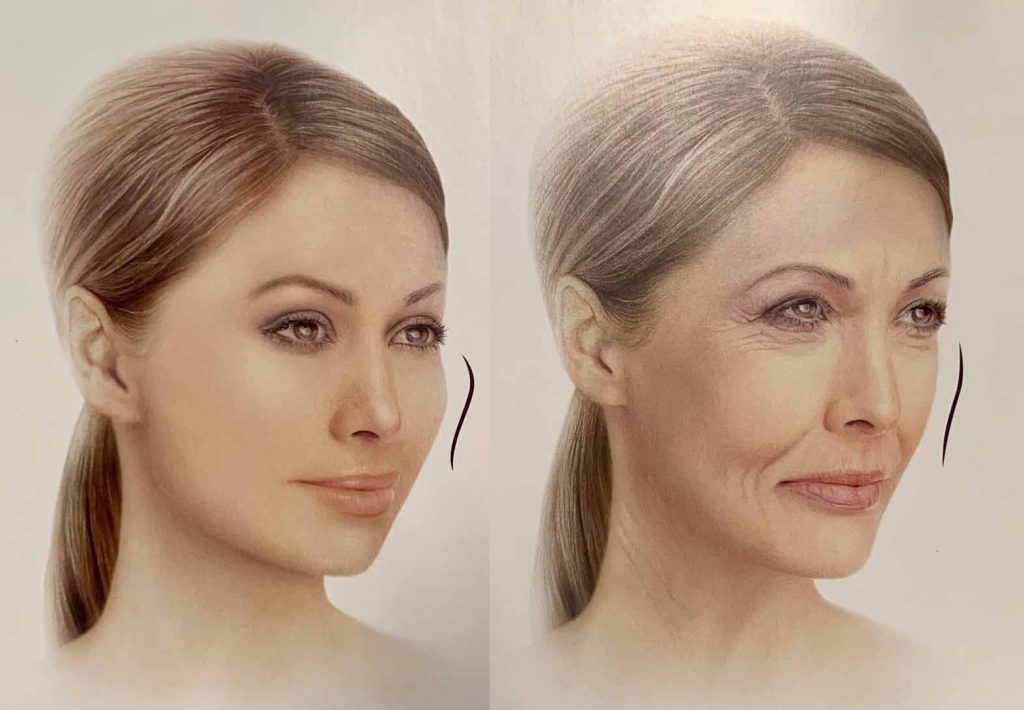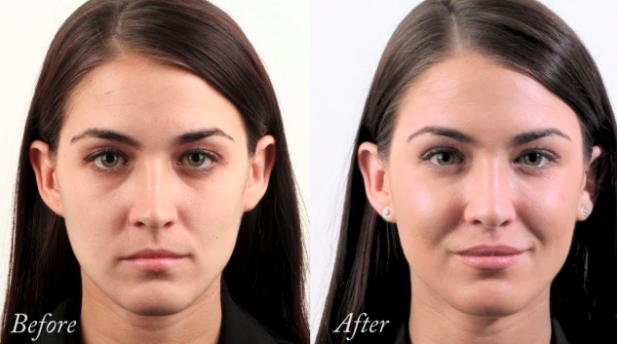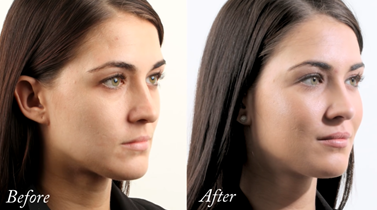Last updated May 2023
As we age, our faces naturally lose volume. Volume loss occurs in the skin, fat, muscle and bone, leading to the appearance of facial folds such as the nasolabial folds. In a study by Boehm et al., it was found in facial CT scans that the superficial and deep midface lost volume, 26.10 mL to 23.15 mL and 11.01 mL to 8.98 mL, respectively, over ten years.
Dermal fillers can restore mid-face or cheek volume and help reverse this age-related change.
What does cheek filler do?
As cheeks lose volume with ageing, the face may become less proportionate and balanced. Dermal filler injections can replace the volume in the cheeks, help to regain youthful facial proportions and rejuvenate the face. As skin sags with ageing, replacement of cheek volume using dermal fillers can help to lift this sag.
For the younger population, there may be volume deficiencies in the cheek that are not due to ageing. For example, the maxilla (the bone that forms the upper jaw) may be underdeveloped, leading to a flatter mid-face and disproportion of the mid-face with the rest of the face. Cheek filler can help to correct this by adding volume to this area.
Mid-cheek filler can also support the lower eyelid to help reduce the appearance of tear troughs or ‘eye bags’. Cheek filler can support the ligaments around the lower eyelid that may sag with time.
Most people will also naturally have some asymmetry of the cheeks. Cheek filler can help balance pre-existing asymmetry to a certain degree, although absolute symmetry is unlikely.
In summary, using dermal fillers in the cheeks can help enhance the following:
- The shape and proportions of your cheeks in relation to the rest of the face
- The size of your cheeks in relation to the rest of the face
- The skin on your cheeks
- Provide structural support for the lower eyelid
- Improve the symmetry of your cheeks
The ogee face curve
The ogee curve, a term commonly used in architecture, describes an S-shaped curve. In cosmetic medicine, the term “ogee face curve” refers to a specific facial contour. It describes the face’s gentle, double-curved shape when viewed from the side, as shown in the diagram below.
The ogee face curve is characterised by a convexity in the forehead area, followed by a slight concavity or flatness in the upper eyelid region. The curve then transitions into a convex contour in the mid-face or cheek area and finally curves inward slightly along the jawline.
Cheek filler treatment restores the ogee face curves by adding volume to specific areas.

Diagram to demonstrate the ogee curve
If you observe the light reflection from a cheek with an ogee curve, you will notice a certain point where this light reflection is strongest. Often this point coincides with the point of maximal projection. Mathematical formulas using the Golden Ratio, or Phi, can be used to find and replace volume in this point on the cheek.
Options for enhancing cheek volume
There are several options available for enhancing cheek volume. These include:
- Dermal Fillers: Dermal fillers, such as hyaluronic acid fillers, are commonly used to augment cheek volume. The filler is injected into specific areas of the cheeks to restore volume and enhance contours.
- Fat Transfer: Fat transfer, also known as fat grafting or fat injections, involves the removal of fat from one area of the body (typically through liposuction) and injecting it into the cheeks to add volume. Fat transfer requires a surgical procedure and may have a longer recovery time than dermal fillers. Fat transfer is not performed at Victorian Cosmetic Institute.
- Cheek Implants: Cheek implants are solid materials typically made of silicone or other biocompatible substances surgically placed in the cheeks to enhance volume and contour. This procedure involves an incision and the insertion of implants to achieve the desired effect. Recovery time may be longer compared to non-surgical options.
- Thread Lift: A thread lift is a procedure where dissolvable threads are inserted under the skin to lift and support sagging tissues, including the cheeks. The threads stimulate collagen production, providing a subtle lift and enhancing volume.
Cheek filler consultation and assessment
When you have your initial consultation, the cosmetic doctor will physically examine your cheek shape, structure and size. Cheek enhancement with fillers should be done with consideration of the facial proportions. Your doctor will also discuss your treatment expectations and your overall suitability for treatment.
Factors such as cheek volume, pre-existing asymmetries, skin quality, skin laxity and facial proportions will need careful assessment. This can be done with a physical examination and tools like the Golden Ratio callipers.
Your practitioner will advise the amount of filler required and the cost of the dermal filler treatment.
How cheek filler is performed
Your cheek filler treatment will be administered using either a needle or a cannula. A blunt-tipped cannula is usually preferred. Cannulas are generally longer than their counterpart needles; fewer entry points are needed, reducing the risk of bruising. A local anaesthetic will be used to numb the site, and the doctor will use a technology called Accuvein to visualise and map your veins.
We recommend getting filler higher up in the cheeks to support the lower eyelid, lift the cheekbones, and help create facial symmetry. It is advised to give yourself some recovery time afterwards, as there may be some swelling or bruising after getting cheek fillers.
Our experienced cosmetic doctors and nurses prefer to use blunt micro-cannula. The cannula’s blunt tip is passed through a needle’s entry point. The cheek fillers are then injected from the same point without making another puncture site. You can read more about our blunt cannula technique here.
Many cheek fillers are blended with a local anaesthetic to reduce discomfort during your cheek treatment further. The local anaesthetic will partially numb the dermal filler injection site. You can read more details about dermal fillers here.
What are the risks of cheek filler?
When administered by an experienced cosmetic doctor or practitioner, dermal fillers can effectively replenish lost volume in the face. Dermal fillers are composed of hyaluronic acid, also naturally found in the skin. Dermal fillers may restore facial volume loss in areas such as the cheeks.
As with all cosmetic procedures, there are risks involved. The risks or side effects when injecting the face include;
- Bruising
- Swelling
- Lumps
- Asymmetry
- Overtreatment, which may require correction with a filler dissolver
- Under-treatment, which may require modification with more filler.
Less common risks and side effects include:
- Nodules or granulomas (immune-mediated reactions to filler)
- Allergic reactions
- Infection
- Vascular occlusion. Vascular occlusion is a rare but severe complication where the filler is injected into a facial artery. It occludes its blood supply, leading to the possible death of the skin supplied by the artery or even blindness or stroke. To help avoid this complication, ultrasound can be used to scan for arteries in the treatment area before and during the treatment.
Skincare and make-up to use after your treatment
Dermal filler treatment is complemented by healthy skin. Using products such as Vitamin A (retinol), Vitamin B (niacinamide) and sunscreen improves skin quality in the longer term.
- Vitamin A – Retinol is a molecule that improves skin texture, dryness, and fine lines.
- Niacinamide – Nicotinamide and its derivatives have been shown to increase the expression of collagen (type I, III, and V), elastin, and fibrillin (1 and 2) in the skin
- Sunscreen – Regular sunscreen use delays skin ageing in healthy, middle-aged men and women.
For immediate post-filler skincare, a hydrating serum such as the Aspect Dr Hyaluronic Serum may assist in boosting hydration and repairing inflamed skin. To learn more about hydration-boosting serums, click here.
After having cheek filler, we generally advise you to avoid make-up for at least one day to reduce the risk of infection.
How much cheek filler should I have, and how often?
The amount of filler will vary depending on factors such as age, size of the cheeks in proportion to the rest of the face, and degree of pre-existing cheek volume loss.
Many clinics advertise packages for 1 or 2 mL of cheek fillers to be performed every 6 to 12 months. However, MRI scans show that the filler persists for many years rather than months. Therefore, more significant amounts of filler repeated frequently are likely to accumulate in the face and lead to overfilling.
Lymphatic channels can also be obstructed by excess filler in the cheeks, and care needs to be taken to use the right amount of filler placed deeply to avoid lymphatic obstruction.
In most cases, we recommend using less than 1mL per session and treating various parts of the face, not just the cheeks. The treatment results can be reviewed yearly and only repeated if required.
How long does cheek filler last?
This will depend on the type of filler used. At Victorian Cosmetic Institute, we use hyaluronic acid fillers for cheek enhancement. In 2019, Dr Mobin Master published a study in showing that temporary hyaluronic acid fillers may last significantly longer than the 6 to 18 months they are reported to last. The study showed temporary hyaluronic acid filler lasting 2 to 12 years, as seen on MRI scans.
Case Studies
Before and after cheek filler
This patient came to the Victorian Cosmetic Institute wanting to treat her upper face. She was given dermal fillers in her cheeks to add lift at the golden ratio points, and she was also given forehead filler and lip filler.


Why should I choose the Victorian Cosmetic Institute as my provider of cheek filler?
Dermal fillers can help address volume loss as a result of ageing. The doctors at Victorian Cosmetic Institute provide a thorough initial consultation to ascertain your particular requirements, discuss your expectations and determine whether you are suitable for cheek filler treatment.
You can contact our Customer Care team on 1300 863 824 to schedule a consultation with one of our doctors or book your consultation online.